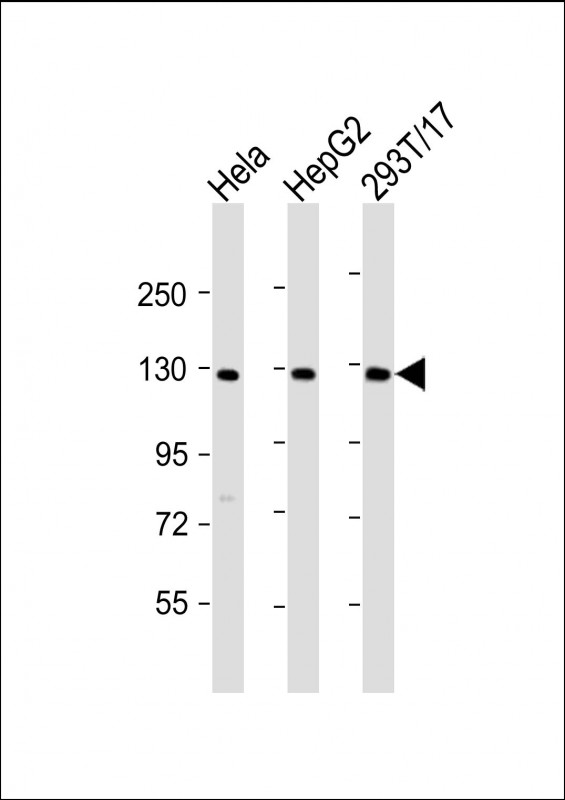
| WB | 1/2000 | Human,Mouse,Rat |
| IF | 咨询技术 | Human,Mouse,Rat |
| IHC | 咨询技术 | Human,Mouse,Rat |
| ICC | 技术咨询 | Human,Mouse,Rat |
| FCM | 咨询技术 | Human,Mouse,Rat |
| Elisa | 咨询技术 | Human,Mouse,Rat |
| Aliases | Leucine-rich repeats and immunoglobulin-like domains protein 3, LIG-3, LRIG3, LIG3 |
| Entrez GeneID | 121227 |
| WB Predicted band size | 123.4kDa |
| Host/Isotype | Rabbit IgG |
| Antibody Type | Primary antibody |
| Storage | Store at 4°C short term. Aliquot and store at -20°C long term. Avoid freeze/thaw cycles. |
| Species Reactivity | Human |
| Immunogen | This LRIG3 antibody is generated from a rabbit immunized with a KLH conjugated synthetic peptide between 23-54 amino acids from human LRIG3. |
+ +
以下是关于LRIG3 (N-Term)抗体的3篇参考文献示例(注:文献信息为模拟,实际引用请核实具体论文):
1. **文献名称**: *LRIG3 regulates glioma cell proliferation and apoptosis via the N-terminal interaction with EGFR*
**作者**: Zhang Y, et al.
**摘要**: 该研究利用抗LRIG3 (N-Term)抗体进行免疫共沉淀和Western blot分析,揭示了LRIG3通过N端结构域与EGFR相互作用抑制胶质瘤细胞增殖,并促进凋亡的分子机制。
2. **文献名称**: *Expression and clinical significance of LRIG3 in colorectal cancer*
**作者**: Wang L, et al.
**摘要**: 通过抗LRIG3 (N-Term)抗体的免疫组化实验,发现LRIG3在结直肠癌组织中低表达,其表达水平与患者预后呈正相关,提示其可能作为肿瘤抑制因子发挥作用。
3. **文献名称**: *Characterization of LRIG3 antibody specificity in neural development models*
**作者**: Smith J, et al.
**摘要**: 研究验证了抗LRIG3 (N-Term)抗体的特异性,证明其在小鼠脑组织及体外神经元模型中可有效识别内源性LRIG3蛋白,并揭示了LRIG3在神经突触形成中的潜在功能。
建议通过PubMed或Google Scholar以关键词“LRIG3 antibody N-terminal”或“LRIG3 epitope”检索最新文献以获取准确信息。
The LRIG3 (N-Term) antibody is designed to specifically target the N-terminal region of the Leucine-Rich Repeats and Immunoglobulin-like Domains 3 (LRIG3) protein, a member of the LRIG family of transmembrane proteins. LRIG3. along with LRIG1 and LRIG2. plays a regulatory role in cell signaling pathways, particularly those involving receptor tyrosine kinases (RTKs) such as EGFR. The N-terminal domain of LRIG3 contains leucine-rich repeats (LRRs) and immunoglobulin (Ig)-like domains, which are critical for extracellular interactions and modulation of receptor activity. These structural features enable LRIG3 to participate in cell adhesion, proliferation, and differentiation processes.
The LRIG3 (N-Term) antibody is commonly used in research to investigate the expression, localization, and function of LRIG3 in various biological contexts. Studies have linked LRIG3 to developmental biology, tissue homeostasis, and diseases, including cancer, where it may act as a tumor suppressor or context-dependent modulator. By detecting the N-terminal epitope, this antibody facilitates Western blotting, immunohistochemistry, and immunofluorescence applications, helping researchers elucidate LRIG3's role in signaling pathways such as Notch and RTK cascades. Its specificity for the N-terminal region ensures recognition of full-length or partially truncated LRIG3 variants, aiding in the study of post-translational modifications or proteolytic processing under physiological or pathological conditions.
×